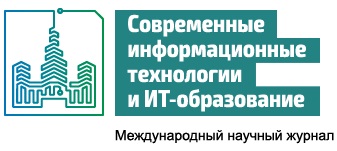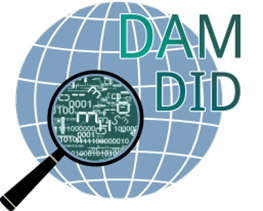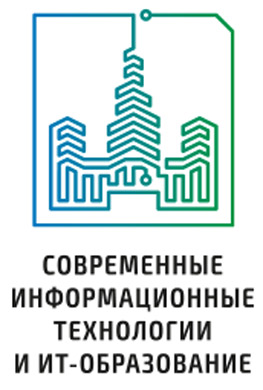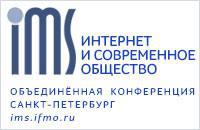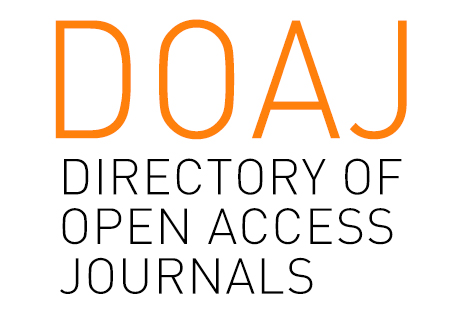Учет ограничений в задаче визуального позиционирования на основе управления с прогнозирующими моделями
Аннотация
Статья посвящена задаче визуального позиционирования произвольного полноприводного подвижного объекта на плоскости. На объекте жестко закреплена видеокамера, направленная на визуальный маркер, параллельный плоскости движения объекта. Маркер представляет собой квадрат, углы которого являются точками интереса. Управление объектом осуществляется путем задания вектора скоростей. Задача заключается в синтезе такого управления, которое обеспечит желаемое положение проекции визуального маркера в плоскости изображения. Задача осложняется тем фактом, что область видимости камеры ограничена, и при выходе проекции одного из углов маркера за пределы этой области, весь маркер перестает распознаваться. Таким образом, дополнительным требованием к управлению является постоянное удержание проекции маркера в пределах области видимости. Для решения задачи визуального позиционирования без учета ограничений, как правило, используется метод управления с визуальной обратной связью (visual servoing). Учет заданных ограничений возможен при использовании подхода управления с прогнозирующими моделями. Таким образом, в статье представлено решение задачи визуального позиционирования с учетом ограничений на перемещение проекции визуального маркера при помощи комбинации методов управления с визуального обратной связью и управления с прогнозирующими моделями. Для демонстрации работоспособности представленного подхода приводятся результаты экспериментов с компьютерной моделью полноприводного плоского объекта управления.
Литература
2. Garrido-Jurado S., Muñoz-Salinas R., Madrid-Cuevas F.J., Marín-Jiménez M.J. Automatic generation and detection of highly reliable fiducial markers under occlusion. Pattern Recognition. 2014;47(6):2280-2292. https://doi.org/10.1109/MRA.2007.339609
3. Chaumette F., Hutchinson S. Visual Servo Control: Basic Approaches. IEEE Robotics & Automation Magazine. 2006;13(4):82-90. https://doi.org/10.1109/MRA.2006.250573
4. Chaumette F., Hutchinson S. Visual Servo Control: Advanced Approaches. IEEE Robotics & Automation Magazine. 2007;14(1):109-118. https://doi.org/10.1109/MRA.2007.339609
5. Malis E., Chaumette F., Boudet S. 2 1/2 D Visual Servoing. IEEE Transactions on Robotics and Automation. 1999;15(2):238-250. https://doi.org/10.1109/70.760345
6. Nazari A.A., Zareinia K., Janabi-Sharifi F. Visual Servoing of Continuum Robots: Methods, Challenges, and Prospect. International Journal of Medical Robotics and Computer Assisted Surgery. 2022;18:e2384. https://doi.org/10.1002/rcs.2384
7. Cong V.D., Hanh L.D. A review and performance comparison of visual servoing controls. International Journal of Intelligent Robotics and Applications. 2023;7(1):65-90. https://doi.org/10.1007/s41315-023-00270-6
8. Al-Shanoon A., Lang H. Robotic manipulation based on 3-D visual servoing and deep neural networks. Robotics and Autonomous Systems.2022;152:104041. https://doi.org/10.1016/j.robot.2022.104041
9. Huang H., Bian X., Cai F., Li J., Jiang T., Zhang, Z., Sun C. A review on visual servoing for underwater vehicle manipulation systems automatic control and case study. Ocean Engineering. 2022;260:112065. https://doi.org/10.1016/j.oceaneng.2022.112065
10. Li C., Li B., Wang R.,et al.A survey on visual servoing for wheeled mobile robots. International Journal of Intelligent Robotics and Applications. 2021;5:203-218. https://doi.org/10.1007/s41315-021-00177-0
11. Li C., Zhang X., Gao H., Wang R., Fang Y. Bridging the Gap Between Visual Servoing and Visual SLAM: A Novel Integrated Interactive Framework. IEEE Transactions on Automation Science and Engineering. 2022;19(3):2245-2255. https://doi.org/10.1109/TASE.2021.3067792
12. Keipour A., Pereira G.A.S., Bonatti R., Garg R., Rastogi P., Dubey G., Scherer S. Visual Servoing Approach to Autonomous UAV Landing on a Moving Vehicle.Sensors.2022;22:6549. https://doi.org/10.3390/s22176549
13. Aghili F. Fault-Tolerant and Adaptive Visual Servoing for Capturing Moving Objects. IEEE/ASME Transactions on Mechatronics. 2022;27(3):1773-1783. https://doi.org/10.1109/TMECH.2021.3087729
14. Zhang H., Li M., Ma S., Jiang H., Wang H. Recent Advances on Robot Visual Servo Control Methods. Recent Patents on Mechanical Engineering. 2021;14(3):298-312. https://doi.org/10.2174/2212797613999201117151801
15. Sotnikova M.V., Veremey E.I. Synthesis of Astatic MPC-Regulator for Magnetic Levitation Plant. Transactions on Systems and Control. 2017;16:355-361. Available at: https://wseas.com/journals/articles.php?id=2825 (accessed 26.04.2024).
16. Schwenzer M., Ay M., Bergs T.,et al.Review on model predictive control: an engineering perspective. The International Journal of Advanced Manufacturing Technology. 2021;117(5-6):1327-1349. https://doi.org/10.1007/s00170-021-07682-3
17. Elmorshedy M.F., Xu W., El-Sousy F.F.M., Islam M.R., Ahmed A.A. Recent Achievements in Model Predictive Control Techniques for Industrial Motor: A Comprehensive State-of-the-Art. IEEE Access. 2021;9:58170-58191. https://doi.org/10.1109/ACCESS.2021.3073020
18. Foucquier A., Robert S., Suard F., Stephan L., Jay A. State of the art in building modelling and energy performances prediction: a review. Renewable and Sustainable Energy Reviews. 2013;23:272-288. https://doi.org/10.1016/j.rser.2013.03.004
19. Samuel M., Mohamad M., Hussein M., Mad Saad S. Lane Keeping Maneuvers Using Proportional Integral Derivative (PID) and Model Predictive Control (MPC). Journal of Robotics and Control (JRC). 2021;2(2):78-82. https://doi.org/10.18196/jrc.2256
20. Wang D.,et al. Model Predictive Control Using Artificial Neural Network for Power Converters.IEEE Transactions on Industrial Electronics. 2022;69(4):3689-3699. https://doi.org/10.1109/TIE.2021.3076721
21. Salzmann T., Kaufmann E., Arrizabalaga J., Pavone M., Scaramuzza D., Ryll M. Real-Time Neural MPC: Deep Learning Model Predictive Control for Quadrotors and Agile Robotic Platforms.IEEE Robotics and Automation Letters. 2023;8(4):2397-2404. https://doi.org/10.1109/LRA.2023.3246839
22. Nguyen K., Schoedel S., Alavilli A., Plancher B., Manchester Z. TinyMPC: Model-Predictive Control on Resource-Constrained Microcontrollers. In: 2024 IEEE International Conference on Robotics and Automation (ICRA). Yokohama, Japan: IEEE Press; 2024. p. 1-7. https://doi.org/10.1109/ICRA57147.2024.10610987
23. Rodriguez J.,et al. Latest Advances of Model Predictive Control in Electrical Drives Part II: Applications and Benchmarking with Classical Control Methods.IEEE Transactions on Power Electronics. 2022;37(5):5047-5061. https://doi.org/10.1109/TPEL.2021.3121589
24. Harbi I.,et al. Model-Predictive Control of Multilevel Inverters: Challenges, Recent Advances, and Trends.IEEE Transactions on Power Electronics. 2023;38(9):10845-10868. https://doi.org/10.1109/TPEL.2023.3288499
25. Sotnikova M.V., Veremey E.I. Dynamic Positioning Based on Nonlinear MPC. IFAC Proceedings Volumes. 2013;46(33):37-42. https://doi.org/10.3182/20130918-4-JP-3022.00058

Это произведение доступно по лицензии Creative Commons «Attribution» («Атрибуция») 4.0 Всемирная.
Редакционная политика журнала основывается на традиционных этических принципах российской научной периодики и строится с учетом этических норм работы редакторов и издателей, закрепленных в Кодексе поведения и руководящих принципах наилучшей практики для редактора журнала (Code of Conduct and Best Practice Guidelines for Journal Editors) и Кодексе поведения для издателя журнала (Code of Conduct for Journal Publishers), разработанных Комитетом по публикационной этике - Committee on Publication Ethics (COPE). В процессе издательской деятельности редколлегия журнала руководствуется международными правилами охраны авторского права, нормами действующего законодательства РФ, международными издательскими стандартами и обязательной ссылке на первоисточник.
Журнал позволяет авторам сохранять авторское право без ограничений. Журнал позволяет авторам сохранить права на публикацию без ограничений.
Издательская политика в области авторского права и архивирования определяются «зеленым цветом» в базе данных SHERPA/RoMEO.
Все статьи распространяются на условиях лицензии Creative Commons «Attribution» («Атрибуция») 4.0 Всемирная, которая позволяет другим использовать, распространять, дополнять эту работу с обязательной ссылкой на оригинальную работу и публикацию в этом журналe.
